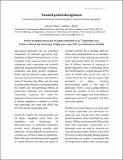Files in this item
Toward pesticidovigilance
Item metadata
| dc.contributor.author | Milner, Alice | |
| dc.contributor.author | Boyd, Ian L. | |
| dc.date.accessioned | 2018-05-16T11:30:05Z | |
| dc.date.available | 2018-05-16T11:30:05Z | |
| dc.date.issued | 2017-09-22 | |
| dc.identifier | 252042017 | |
| dc.identifier | 8294f8a1-42aa-455f-82a4-b02f6561cab5 | |
| dc.identifier | 85029869061 | |
| dc.identifier | 000411337700021 | |
| dc.identifier.citation | Milner , A & Boyd , I L 2017 , ' Toward pesticidovigilance ' , Science , vol. 357 , no. 6357 , pp. 1232-1234 . https://doi.org/10.1126/science.aan2683 | en |
| dc.identifier.issn | 0036-8075 | |
| dc.identifier.uri | https://hdl.handle.net/10023/13347 | |
| dc.description.abstract | Agricultural pesticides are an important component of intensive agriculture and, therefore, of global food production. In the European Union, ∼500 active substances used in pesticides are approved, including insecticides, fungicides, herbicides, and plant growth regulators. When used at industrial scales, pesticides can harm the environment (1), but there is a trade-off between this effect and the need to produce food. Recent uncertainties about the health and environmental effects of glyphosate herbicide and neonicotinoid insecticides underline the need for regulation to be sensitive to this trade-off (2, 3). Better regulation is needed to control how pesticides are used and affect the environment at a landscape scale. | |
| dc.format.extent | 3 | |
| dc.format.extent | 74630 | |
| dc.language.iso | eng | |
| dc.relation.ispartof | Science | en |
| dc.subject | QH301 Biology | en |
| dc.subject | S Agriculture (General) | en |
| dc.subject | T-NDAS | en |
| dc.subject | SDG 2 - Zero Hunger | en |
| dc.subject.lcc | QH301 | en |
| dc.subject.lcc | S1 | en |
| dc.title | Toward pesticidovigilance | en |
| dc.type | Journal article | en |
| dc.contributor.institution | University of St Andrews. School of Biology | en |
| dc.contributor.institution | University of St Andrews. Marine Alliance for Science & Technology Scotland | en |
| dc.contributor.institution | University of St Andrews. Scottish Oceans Institute | en |
| dc.contributor.institution | University of St Andrews. Institute of Behavioural and Neural Sciences | en |
| dc.contributor.institution | University of St Andrews. Sea Mammal Research Unit | en |
| dc.identifier.doi | https://doi.org/10.1126/science.aan2683 | |
| dc.description.status | Peer reviewed | en |
| dc.date.embargoedUntil | 2018-03-22 |
This item appears in the following Collection(s)
Items in the St Andrews Research Repository are protected by copyright, with all rights reserved, unless otherwise indicated.

